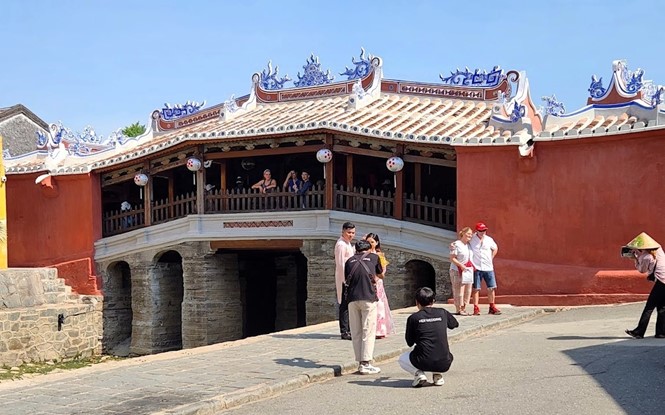The Famous tiled bridges
* How many famous tile-roofed bridges are there in Vietnam, and which one is considered the "oldest" and most beautiful? (My Linh, Cam Le District, Da Nang).
 |
| Chua Cau (the Bridge Pagoda) in Hoi An is one of Vietnam's three most beautiful tile-roofed bridges. IN PHOTO: Visitors take commemorative photos after the restoration of pagoda. Photo: V.T.L. |
Many newspapers have compiled and reported on Vietnam's famous tiled bridges. According to Dan Tri Newspaper (dantri.com.vn), the five most beautiful ancient tiled bridges in Vietnam are designed in a special style which is "House above, bridge below."
Chua Cau (Bridge Pagoda) has been chosen as the symbol of Hoi An City. This structure was built by Japanese merchants who came to trade in Vietnam in the 17th century. The bridge spans approximately 18 meters across a small canal that flows into the Thu Bon River. Above its main entrance hangs a large wooden plaque with three embossed Chinese characters: “Lai Vien Kieu”, meaning "Bridge of friends from afar”.
Thanh Toan Tiled Bridge is located about 8 kilometers southeast of Hue City in Thuy Thanh Commune, Huong Thuy District. The bridge is about 17 meters long, 4 meters wide and divided into 7 compartments. The compartment section serves as a shrine dedicated to Tran Thi Dao, the benefactor who funded the bridge's construction in the 18th century to provide the villagers with a more convenient crossing.
Phat Diem Tile-Roofed Bridge spans An River and located in the heart of Phat Diem Town, Kim Son District, approximately 30 kilometers from Ninh Binh City. The bridge stretches 36 meters in length and 3 meters in width, and it consists of three spans, each of which four sections. At both ends of the bridge, stone steps are provided, allowing only pedestrians to cross. The bridge features a traditional gabled roof, covered with the signature red tiles of the Northern Delta region, adding to its historical and architectural charm.
Cho Thuong Tile-Roofed Bridge is located in Thuong Nong Hamlet, Binh Minh Commune, Nam Truc District, Nam Dinh Province. The bridge spans Ngoc River near Cho Thuong Market, hence its name is Cho Thuong Tile-Roofed Bridge. Built in the 18th century, the bridge was funded by the donations of Nguyen Thi Ngoc Xuan, a royal consort of Lord Trinh, who was a native of Thuong Nong Village.
Chua Luong Tile-Roofed Bridge is located in Hai Anh Commune, Hai Hau District, Nam Dinh Province, spanning the Hoanh River and about 100 meters from Chua Luong Pagoda. At the bridge's entrance, two majestic stone nghe (mythical lion-like creatures) hold a scroll engraved with the four words “Quan Phuong Xa Kieu” (The Bridge of Quan Phuong Village). On both sides of the bridge are curved corridors, offering a resting spot for pedestrians. The outer edges of the corridors are two curved corridors with wooden railings for pedestrians to stop and rest.
According to the official electronic portal of Nam Dinh Provincial Party Committee (namdinh.org.vn), Chua Luong, also known as the Hundred-Gian Pagoda, formally named Phuc Lam Tu, was built during the reign of King Le Hong Thuan (1509–1515) in the late 15th to early 16th century. The history of the pagoda and the bridge is closely associated to the coastal land reclamation efforts that took place 500 years ago in the Hai Hau coastal region. The bridge, constructed approximately 300–400 years ago during the Le Dynasty, is renowned as one of the most beautiful ancient bridges in northern Vietnam.
According to ancient documents, the bridge was initially just a simple post without a tiled roof, and only covered with basic grass. In the 17th century, the bridge was repaired and renovated several times to match the structure and landscape of Chua Luong complex. The most significant restoration took place in 1922, when the bridge was covered with tiles. The entire bridge consists of 9 curved sections resembling a rainbow, with 40 round wooden columns, all made of ironwood. On both sides, there are two long corridors that serve as resting benches.
The soft, graceful architectural style of the bridge gives Chua Luong Bridge a unique, refined quality, which helps distinguish it from other bridges in different regions. Therefore, Chua Luong Bridge in Hai Hau District (Nam Dinh), along with Thanh Toan Bridge (Hue) and Chua Cau (Hoi An), was chosen as one of the three most beautiful tiled bridges in Vietnam, and stamps featuring these bridges were issued in 2012.
Reporting by DNCT – Translating by HONG VAN